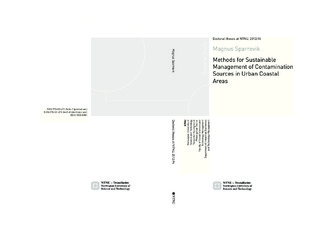| dc.contributor.author | Sparrevik, Magnus | nb_NO |
| dc.date.accessioned | 2014-12-19T14:28:02Z | |
| dc.date.available | 2014-12-19T14:28:02Z | |
| dc.date.created | 2012-03-19 | nb_NO |
| dc.date.issued | 2012 | nb_NO |
| dc.identifier | 510950 | nb_NO |
| dc.identifier.isbn | 978-82-471-3465-8 | nb_NO |
| dc.identifier.uri | http://hdl.handle.net/11250/266054 | |
| dc.description.abstract | Managing contaminated urban coastal areas is an important issue in today’s society. Harbor areas are transformed from industrial sites and shipyards, to housing areas with high environmental requirements. The use of coastal areas for aquaculture and fishing activities increases the need for cleanup of previous contamination sources. High environmental standards when handling dredged material from harbors and industrial activities are also required in our society today.
Many countries including Norway have based the management for the coastal zone environment on use of health and ecological risk assessments (HERA). This means that there should be no adverse risk to human or ecological life due to exposure of contaminants from sediments or water. This single criteria framework based on the precautionary principle is inherently conservative and may introduce costly and resource consuming remediation methods with isolated focus on sediment disposal instead of beneficial use.
In order to take more balanced management remedial decisions this thesis promotes a shift in management of contaminated areas from use of HERA alone to a multicriteria focused approach incorporating sustainable values.
The main contributions of this thesis are:
• Knowledge on how the present Norwegian management system deviates from a holistic risk governance concept.
• Wider understanding of how social factors as risk perceptive values are influencing management processes.
• A life cycle impact assessment model (LCIA) for marine sediment contamination allowing use of life cycle assessments for contaminated sediment problems.
• A multicriteria involvement model (MIP) to promote participatory involvement processes
• An integrative stochastic multicriteria decision model (SMCA) supporting sustainable decisions in contaminated sediment management. | nb_NO |
| dc.language | eng | nb_NO |
| dc.publisher | NTNU | nb_NO |
| dc.relation.ispartofseries | Doctoral Theses at NTNU, 1503-8181; 2012:94 | nb_NO |
| dc.relation.haspart | Sparrevik, Lars Magnus; Breedveld, Gijs D.. From Ecological Risk Assessments to Risk Governance. Evaluation of the Norwegian Management System for Contaminated Sediments. Integrated Environmental Assessment and Management. (ISSN 1551-3793). 6(2): 240-248, 2010. <a href='http://dx.doi.org/10.1897/IEAM_2009-049.1'>10.1897/IEAM_2009-049.1</a>. | nb_NO |
| dc.relation.haspart | Sparrevik, Lars Magnus; Ellen, Gerald Jan; Duijn, Mike. Evaluation of factors affecting stakeholder risk perception of contaminated sediment disposal in Oslo harbour. Environmental Science and Technology. (ISSN 0013-936X). 45(1): 118-124, 2011. <a href='http://dx.doi.org/10.1021/es100444t'>10.1021/es100444t</a>. | nb_NO |
| dc.relation.haspart | Sparrevik, Lars Magnus; Barton, David Nicholas; Bates, M; Linkov, Igor. Use of Stochastic Multi-criteria Decision Analysis to Support Sustainable Management of Contaminated Sediments. Environmental Science and Technology. (ISSN 0013-936X). 46(3): 1326-1334, 2012. <a href='http://dx.doi.org/10.1021/es202225x'>10.1021/es202225x</a>. | nb_NO |
| dc.title | Methods for Sustainable Management of Contamination Sources in Urban Coastal Areas | nb_NO |
| dc.type | Doctoral thesis | nb_NO |
| dc.contributor.department | Norges teknisk-naturvitenskapelige universitet, Fakultet for samfunnsvitenskap og teknologiledelse, Institutt for industriell økonomi og teknologiledelse | nb_NO |
| dc.description.degree | PhD i industriell økonomi og teknologiledelse | nb_NO |
| dc.description.degree | PhD in Industrial Economics and Technology Management | en_GB |
